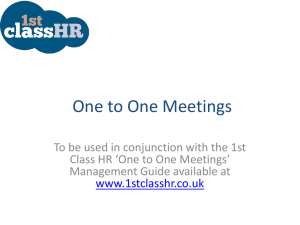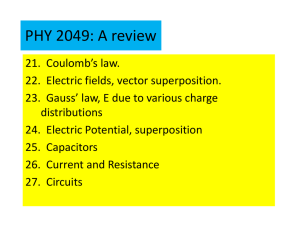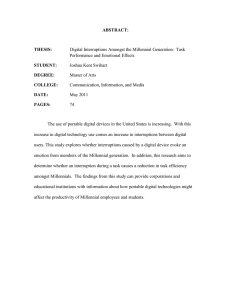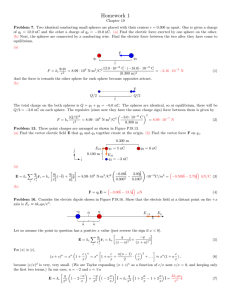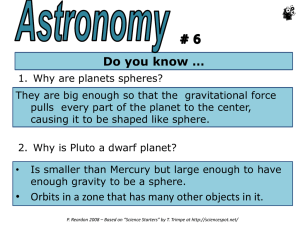Why Do I Keep Interrupting Myself?: Environment, Habit and Self
advertisement
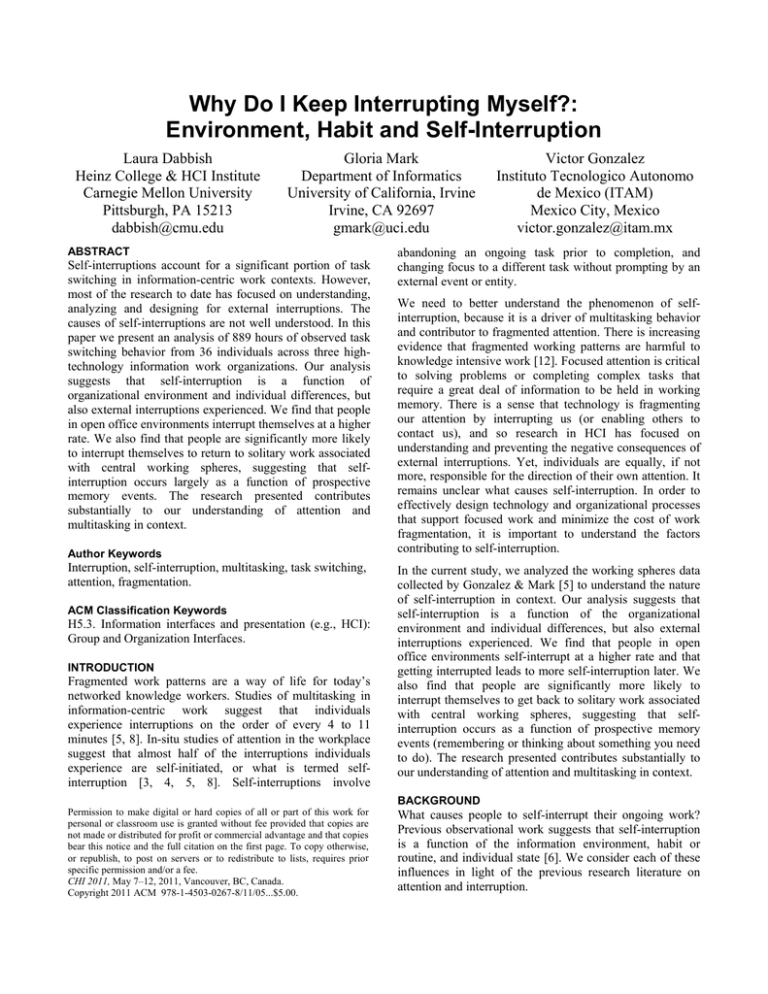
Why Do I Keep Interrupting Myself?: Environment, Habit and Self-Interruption Laura Dabbish Heinz College & HCI Institute Carnegie Mellon University Pittsburgh, PA 15213 dabbish@cmu.edu Gloria Mark Department of Informatics University of California, Irvine Irvine, CA 92697 gmark@uci.edu ABSTRACT Self-interruptions account for a significant portion of task switching in information-centric work contexts. However, most of the research to date has focused on understanding, analyzing and designing for external interruptions. The causes of self-interruptions are not well understood. In this paper we present an analysis of 889 hours of observed task switching behavior from 36 individuals across three hightechnology information work organizations. Our analysis suggests that self-interruption is a function of organizational environment and individual differences, but also external interruptions experienced. We find that people in open office environments interrupt themselves at a higher rate. We also find that people are significantly more likely to interrupt themselves to return to solitary work associated with central working spheres, suggesting that selfinterruption occurs largely as a function of prospective memory events. The research presented contributes substantially to our understanding of attention and multitasking in context. Author Keywords Interruption, self-interruption, multitasking, task switching, attention, fragmentation. ACM Classification Keywords H5.3. Information interfaces and presentation (e.g., HCI): Group and Organization Interfaces. INTRODUCTION Fragmented work patterns are a way of life for today’s networked knowledge workers. Studies of multitasking in information-centric work suggest that individuals experience interruptions on the order of every 4 to 11 minutes [5, 8]. In-situ studies of attention in the workplace suggest that almost half of the interruptions individuals experience are self-initiated, or what is termed selfinterruption [3, 4, 5, 8]. Self-interruptions involve Victor Gonzalez Instituto Tecnologico Autonomo de Mexico (ITAM) Mexico City, Mexico victor.gonzalez@itam.mx abandoning an ongoing task prior to completion, and changing focus to a different task without prompting by an external event or entity. We need to better understand the phenomenon of selfinterruption, because it is a driver of multitasking behavior and contributor to fragmented attention. There is increasing evidence that fragmented working patterns are harmful to knowledge intensive work [12]. Focused attention is critical to solving problems or completing complex tasks that require a great deal of information to be held in working memory. There is a sense that technology is fragmenting our attention by interrupting us (or enabling others to contact us), and so research in HCI has focused on understanding and preventing the negative consequences of external interruptions. Yet, individuals are equally, if not more, responsible for the direction of their own attention. It remains unclear what causes self-interruption. In order to effectively design technology and organizational processes that support focused work and minimize the cost of work fragmentation, it is important to understand the factors contributing to self-interruption. In the current study, we analyzed the working spheres data collected by Gonzalez & Mark [5] to understand the nature of self-interruption in context. Our analysis suggests that self-interruption is a function of the organizational environment and individual differences, but also external interruptions experienced. We find that people in open office environments self-interrupt at a higher rate and that getting interrupted leads to more self-interruption later. We also find that people are significantly more likely to interrupt themselves to get back to solitary work associated with central working spheres, suggesting that selfinterruption occurs as a function of prospective memory events (remembering or thinking about something you need to do). The research presented contributes substantially to our understanding of attention and multitasking in context. BACKGROUND Permission to make digital or hard copies of all or part of this work for personal or classroom use is granted without fee provided that copies are not made or distributed for profit or commercial advantage and that copies bear this notice and the full citation on the first page. To copy otherwise, or republish, to post on servers or to redistribute to lists, requires prior specific permission and/or a fee. CHI 2011, May 7–12, 2011, Vancouver, BC, Canada. Copyright 2011 ACM 978-1-4503-0267-8/11/05...$5.00. What causes people to self-interrupt their ongoing work? Previous observational work suggests that self-interruption is a function of the information environment, habit or routine, and individual state [6]. We consider each of these influences in light of the previous research literature on attention and interruption. Organizational Environment Organizations differ in their culture surrounding appropriate work patterns. Work by Perlow [12] found that a work group or organizational culture can foster a norm of interruption, where individuals are willing to readily interrupt others whenever they need help or information to do their work. This simultaneously means that when individuals need help or information, they may more readily self-interrupt to find others for information. Habit Organizational research has suggested that individuals differ in the extent to which they prefer to work on tasks serially, or monochronically, versus in an interleaved fashion, or polychronically [2]. Polychronics should have higher levels of self-interruption, regardless of the task context or organizational environment. Recent work on self-reported multitasking behavior and attention supports the notion that individuals may differ in their natural tendency to self-interrupt, in part because their attentional capacity is different. Ophir et al. [11] examined the attentional abilities of self-reported ‘media multitaskers’, finding they had a harder time switching between tasks and filtering out stimuli in the periphery. The results from Ophir et al. taken in conjunction with the work on polychronicity, suggests that self-imposed fragmentation may largely be a function of individual differences. Distraction Self-interruptions may, to some extent, be a function of external interruptions experienced. In the workplace, external interruptions can occur in the form of other people stopping into one’s office to talk, incoming telephone calls, e-mail notifications and IM [3, 8, 12]. A great deal of work in HCI and human factors has looked at the momentary consequences of external interruption on task performance (for a review see [9]). This work suggests that interruptions harm productivity in an ongoing task because of the cognitive costs associated with contextswitching, resumption lag, and the potential for errors or mistakes when resuming an interrupted task [1, 9]. However, there is also some evidence that interruptions impose a cognitive cost that persists beyond the interrupting event. Research in cognitive science and organizational behavior suggests there is “attentional residue” following an interrupting event, in that individuals experience working memory impairment on a subsequent task when tasks are left unfinished [1, 7]. It is unclear, however, whether the effect of ‘attentional residue’ persists in a real-world work context. In the work context there are a myriad of additional stimuli demanding attention. If the attentional residue effect persists, we should see a positive relationship between external interruptions experienced in a previous time period and self-interruption in a later time period. In essence, being externally interrupted and forced to attend to another task repeatedly, should serve to distract the user. WORKING SPHERES DATASET The data analyzed in this work was drawn from the study of multitasking conducted by Gonzalez and Mark [5, 8]. Gonzalez and Mark shadowed 36 individuals across three different organizations for three workdays each, for a total of 96 days of observation. During the shadowing, researchers recorded every activity the individual engaged in on a moment-by-moment basis, adapting the protocol used by Mintzberg [10]. This data was then aggregated to the level of working spheres. A working sphere can be thought of as a project: a set of interrelated events one works on toward a particular goal, generally with a specific timeline and set of people. The dataset contains 5,089 total observed working spheres across all 36 individuals. Working spheres were coded as ‘central’, ‘peripheral’ or ‘other’, depending on the individual’s level of accountability for the work. Central working spheres were those for which an individual had primary responsibility and would be held accountable for task completion. Peripheral working spheres were those for which the individual had some, but not primary accountability. ‘Other’ working spheres were meta-work (e.g. organizing files or writing to-do lists) or personal affairs. Working spheres were contiguous in the dataset, with each working sphere having an associated duration before a task switch to a different working sphere. As reported in [5] the average duration of central and peripheral working sphere segments in the dataset (contiguous work on the same project or topic) was 11 minutes 28 seconds. We focused our analysis on task switches between working spheres. A working sphere could end because an individual had naturally completed an event within a working sphere (no interruption), because the individual experienced an interrupting event outside of their control (external interruption, e.g. phone ringing, someone walking into their office), or because the individual interrupted themselves (self-interruption). A behavior was coded as a selfinterruption if, for no apparent reason, the informant stopped what they were doing in the current working sphere prior to event completion and switched to a different working sphere. Out of the 5,089 task switches observed across the entire dataset, there were 3,059 task switches as a result of natural event completion (60%), 1,141 task switches due to external interruptions (22%), and 889 task switches due to self-interruptions (18%). People could switch tasks to engage in a communication (via phone, e-mail, or face to face) or solitary activity (on paper or the computer), and each task switch was labeled with the event type. In addition, task switches were annotated with the number of seconds it took an individual to return to the working sphere after they had switched away from it. Based on the theoretical considerations above, we were interested in examining the relative influence of organizational environment, habit, and distraction on self-interruption rates. RESULTS Table 1 presents descriptive statistics comparing internal, external and non-interrupted task switches. An analysis of differences across these three types of task switches indicates self-interruptions are more similar in incidence and resumption lag to external interruptions than natural event completion. People work longer before selfinterrupting and it takes them longer to resume selfinterrupted tasks, compared to being interrupted externally or completing an event. Number per hour Prior WS Duration in seconds Resumption likelihood Resump -tion lag in seconds Task switches Mean (SD) Mean (SD) Prob. Mean (SD) Self interruption 1.00 (1.30) 518 (761) 70% 2057 (3956) External interruption 1.28 (1.37) 466 (727) 72% 1940 (3671) Event completion 2.26 (2.04) 506 (853) 73% 1556 (3631) Informant was nested within organization to account for the fact that multiple informants were drawn from the same organization. In addition, we included a variable for day which was nested within informant, because the same informants were observed for multiple days. By including these random and fixed effects in our model we accounted for the nested interdependence across observations. Organizational Environment Our results showed that organizational environments varied significantly in their self-interruption rates, and accounted for 13 percent of the variance in self-interruption rates. Informants in group 1, an IT support branch of a financial analysis organization that directly dealt with clients, selfinterrupted at a significantly higher rate than participants in group 2, another IT branch in the same firm that dealt indirectly with clients, or group 3, a group in a high-tech medical device firm. This difference may have been a function of a more distracting or stimulating working environment in group 1. We examined one aspect of the organizational environment: office design. We found that sitting in an open office (cubicle versus enclosed office) was associated with a significant 64% increase in self-interruption (Mean [cubicle]=1.13, SD=1.35; Mean[office]=0.69, SD=1.13). Table 1. Descriptive statistics for task switches by type. Individual Differences Analysis at the Hour Level Using the working spheres dataset, we aggregated events to the level of an hour in the day, for a total of 889 hours in our dataset. For each hour, we created variables for the number of working spheres engaged in during that hour, the average duration of the working spheres within the hour, and the number of external and self-interruptions experienced in that hour as well as the previous hour. Intercept Day Organizational environment Individual Open office seating arrangement Hour in the day Self-Interruption (lagged) External Interruption (lagged) R-squared Root mean squared error Estimate 1.80 *** 0.32 0.32 *** 0.35 *** 0.41 ** -0.09 *** -0.02 0.07 * (SE) (0.31) (0.08) (0.16) (0.08) (0.17) (0.02) (0.03) (0.03) 0.33 1.09 Table 2. Mixed model least squares regression analysis of selfinterruption per hour; *=p<0.05, **=p<0.01, ***=p<0.001. We ran a mixed model linear regression predicting the number of self-interruptions in a given hour. To analyze the influence of organizational environment on selfinterruption, we included a three-level categorical variable in our model. To analyze the influence of individual, we included a categorical variable for informant with 36 levels. Informants significantly differed in their self-interruption rates, accounting for an additional 14 percent of the variance. Interestingly this difference was not accounted for by their job roles-- job role did not show an association with interruption rate when included in the model (F(4, 80)=0.91; p=0.46). It may be that job role (coded as analysts, developers, and managers) did not capture the rich variety of responsibilities accounted for by individuals. Distraction and Time of Day Time of day was significantly associated with interruption rates. Informants interrupted themselves more often the earlier it was in the day and less often as the day progressed. This may be because they were more likely to get into the flow of activity later in the day or perhaps they might have felt additional pressure to complete certain tasks before they had to leave for the evening. External interruptions in the previous hour significantly increased self-interruption in the following hour, with one additional external interruptions resulting in an 8% increase in self-interruption. At the same time, self-interruptions in the previous hour did not show an association with selfinterruptions in the following hour. This result suggests that individuals may experience distraction as a function of external interruptions, shortening their subsequent working spheres. Time and external interruption accounted for only four percent of the variance in self-interruption suggesting their influence was minimal in comparison to individual differences (habit) and organizational environment. We examined the propensity to self-interrupt more fully by next examining what task switch features were most closely associated with a self-interrupt. Using a logistic regression with fixed effects accounting for organization, individual and day, we looked at the likelihood a task switch was a self-interruption as a function of the working sphere to which one switched (central, peripheral or other), the interrupting event (communication, solitary, or other), and the duration of the previous working sphere. This analysis showed that individuals were significantly more likely to self-interrupt into a central working sphere (Mean=23%, SD=39%) over a peripheral or other (Mean=17% and 19%, SD=37%; F (2, 4968) = 7.78; p<0.001). In addition, individuals were significantly more likely to self-interrupt to complete a solitary task (work on paper or the computer; Mean=23%, SD=42%) as opposed to engaging in a communication event (face-to-face talk, phone or e-mail; Mean=16%, SD=36%; F(1, 4968)=22.65; p<0.001). Finally, the duration of the working sphere had only a marginal positive influence on the likelihood of selfinterrupting (F(1,4980)=3.07; p=0.08). DISCUSSION AND CONCLUSIONS Based on working spheres data from 36 individuals across three organizational environments, we examined the factors that influence task switching in the form of a selfinterruption. Although there is some work describing the nature of these self-interruptions, little is known on what causes self-interruption. Our analysis sheds light on this issue-- we found that individuals are significantly more likely to self-interrupt to return to a central working sphere on the computer or on paper. People seem to self-interrupt to switch to solitary work for which they are accountable, suggesting a potential positive aspect of self-interruption for the completion of key work tasks. We found that differences in organizational environments led to different amounts of self-interruption in the data. This builds on the work of Perlow [12] who found that organizational environment affects external interruptions. Information-seeking norms are just one reason that selfinterruption frequency may differ across organizations. The organizational environment may also be designed to be more or less distracting or conducive to self-interruption. We also found that individuals seated in open office environments self-interrupted at a substantially higher rate. In open office layouts all individuals can observe and overhear the interactions of all other individuals which may create an environment conducive to self-interruptions (as well as external interruptions, as [8] found). These results have implications for managers who may want to reconsider open office designs when concentrated work is required because they may foster self-interruption. We found that external interruptions experienced in the previous hour significantly increase the incidence of self interruption in the subsequent hour. One interpretation we offer is that people may be conditioned to self-interrupt. By experiencing external interruptions they may become habituated to self-interrupt. Perhaps if a working sphere segment exceeds the expected average external interrupt time as shown in Table 1 (Mean=466 seconds, SD=727), one might self-interrupt, due to habit. System design should consider interruption trends, e.g. if people are being interrupted a lot or get into a pattern of self-interruption. Our analysis uncovered a set of factors influencing selfinterruption; however a large portion of variance in this behavior remains unexplained. More research is needed to consider additional causes (such as task content) and the consequences of self-interruption to better understand the phenomenon in context. We hope the results we have presented can pave the way for future research on this topic. REFERENCES 1. Altmann, E. M. & Trafton, J. G. Memory for goals: An activation-based model. Cogn Sci, 26, (2002), 39-83. 2. Bluedorn AC, Kaufman CF, & Lane PM. How many things do you like to do at once? An introduction to monochronic and polychronic time. Acad Mgmt Exec, 6, 4 (1992), 17-26. 3. Czerwinski, M., Horvitz, E., & Wilhite, S. A diary study of task switching and interruptions. In Proc. CHI 2004, ACM Press (2004), 175-182. 4. Chong, J., & Siino, R. Interruptions on software teams: A comparison of paired and solo programmers. In Proc. CSCW 2006, ACM Press (2006), 29-38. 5. Gonzalez, V., & Mark, G. “Constant, constant, multitasking craziness”: Managing multiple working spheres. Proc. CHI 2004, ACM Press (2004), 113-120. 6. Jing, J., & Dabbish, L. Self-interruption on the computer: A typology of discretionary task interleaving. In Proc. CHI 2009, ACM Press (2009), 1799-1808. 7. Leroy, S. Why is it so hard to do my work? The challenge of attention residue when switching between work tasks. OBHDP, 109, 3 (2002), 168-181. 8. Mark, G., Gonzalez, V., & Harris, J. No task left behind? Examining the nature of fragmented work. In Proc. CHI 2005, ACM Press (2005), 321-330. 9. McFarlane, D. & Latorella, K.A. The scope and importance of human interruption in human-computer interaction design. Hum-Comp Inter 17, 1(2002), 1-61. 10. Mintzberg, H. The Nature of Managerial Work. Prentice Hall, Englewood Cliffs, N.J, USA, 1973. 11. Ophir, E., Nass, C., Wagner, A.D. Cognitive control in media multitaskers. In Proc. Natl. Acad. Sci. USA, 106 (2009), 15583-15587. 12. Perlow, L. The time famine: Toward a sociology of work time. Admin Sci Quarterly, 44,3 (1999), 57-81.
